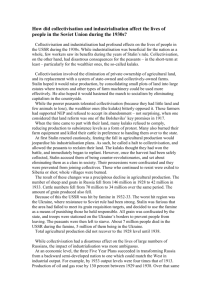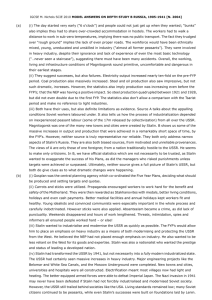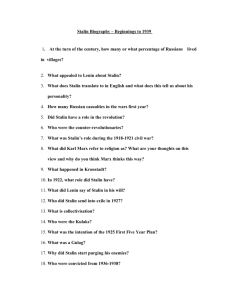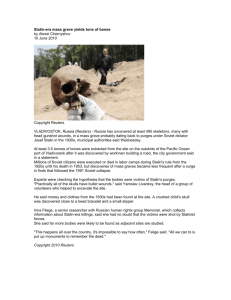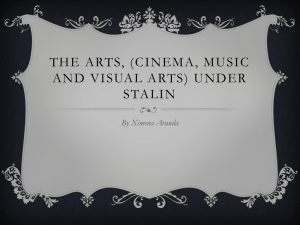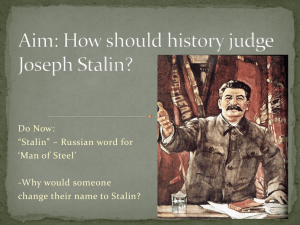stalin and the soviet economy
advertisement
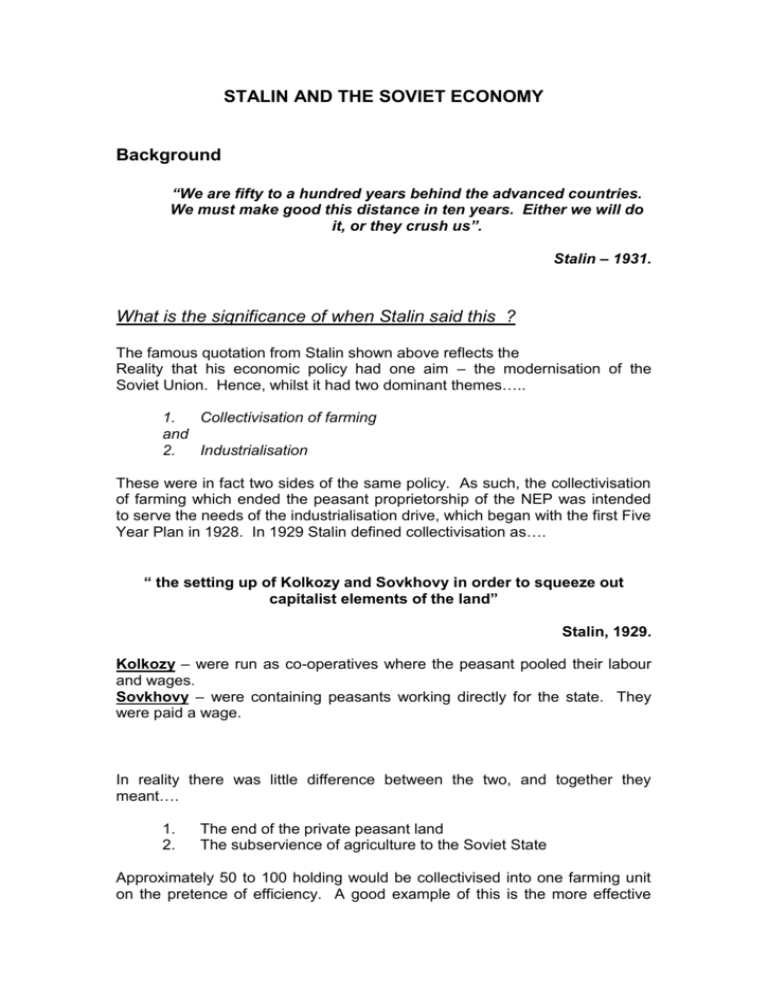
STALIN AND THE SOVIET ECONOMY Background “We are fifty to a hundred years behind the advanced countries. We must make good this distance in ten years. Either we will do it, or they crush us”. Stalin – 1931. What is the significance of when Stalin said this ? The famous quotation from Stalin shown above reflects the Reality that his economic policy had one aim – the modernisation of the Soviet Union. Hence, whilst it had two dominant themes….. 1. Collectivisation of farming and 2. Industrialisation These were in fact two sides of the same policy. As such, the collectivisation of farming which ended the peasant proprietorship of the NEP was intended to serve the needs of the industrialisation drive, which began with the first Five Year Plan in 1928. In 1929 Stalin defined collectivisation as…. “ the setting up of Kolkozy and Sovkhovy in order to squeeze out capitalist elements of the land” Stalin, 1929. Kolkozy – were run as co-operatives where the peasant pooled their labour and wages. Sovkhovy – were containing peasants working directly for the state. They were paid a wage. In reality there was little difference between the two, and together they meant…. 1. 2. The end of the private peasant land The subservience of agriculture to the Soviet State Approximately 50 to 100 holding would be collectivised into one farming unit on the pretence of efficiency. A good example of this is the more effective use of agricultural machinery such as the motorised tractor. Such gains were meant to lead to…. 1. 2. Cheaper food A decrease in the number of workers required in the countryside. These workers were meant to be moved to the new factories. In 1926 Party Congress Stalin summed up his aim as ‘the transformation of our country from an agrarian into an industrial one’. From 1928 Stalin sought to do this by centralisation of the economy. This is sometimes known as the “Second Revolution” or the “Revolution from above” It is important to note that centralising economic planning was not entirely new. Under Lenin Gosplan had been introduced, however Stalin’s plans differed in scale speed and intensity. State control was to be comprehensive and all-embracing. There is some historical debate about Stalin’s motives behind his economic policy, and it is certainly correct to suggest that he had no great reputation as a political thinker. Instead she drew heavily upon the ideas of Preobrazhensky. In reality, he was probably most inspired by the belief that such a hard line policy was the best way to consolidate his authority over the party. This is not the whole picture – beyond any political expediency Stalin did sincerely believe in the need for modernisation. Collectivisation In 1928 collectivisation was voluntary, and Stalin claimed it was a free choice. In reality, it was enforced upon a very reluctant peasantry. He used the natural Bolshevik apathy to the peasants and launched a major propaganda offensive against the Kulaks. He claimed they were holding back the workers revolution. The Kulaks were the richer peasants, and most had made their money under the greater freedom of the NEP. They tended to own the best land, and employed cheap labour to farm it. They were accused of hoarding farm produce, and thus maintaining artificially high food prices. As such, they were meant to be betraying the revolution, and exploiting the workers to become increasingly prosperous. Collectivisation was to be used to break them as a class. However, today historians see the Kulaks as a Stalinist myth. In reality, they were no more than the most industrious and efficient farmers. Lynch comments the “in no sense did they (the Kulaks, constitute the class of exploiting land owners described by Stalin”. However, in the context of the hated of Tsarist landlords, the image proved very effective. Any analysis of the impact of collectivisation should acknowledge that the Russian countryside had been overpopulated for generations. This meant the plan to move the surplus peasant population into the industrial labour force had some grasp on reality. However, the second way by which the policy of collectivisation was meant to help the industrial process was by the sale of surplus grain abroad. This was meant to be converted into foreign currency to invest in the Five Year Plans. However, there simply was no grain surplus to export. Stalin claimed that this was a product of…. 1. 2. Inefficient distribution of resources The corruption of the grain-hoarding Kulaks This was used to justify collectivisation and the onslaught upon the Kulaks. So-called De-kulakisation was undertaken with enthusiasm by some of the poorer peasants, and often old scores were settled. In addition, anti-kulak squads, authorised by Stalin, physically attacked, arrested and or deported them. The OGPU, (which succeeded the Cheka as the state’s security force, and was itself renamed the NKVD in 1931) organised the squads to undertake this work. Between December 1929 and march 1930 almost 60% of farms were collectivised. As a result there was great unrest in the countryside. Peasants in their millions resisted the attempts to collectivise. The level suffering even forced Stalin to call a temporary halt to the process, claiming that problems were only the consequence of over-zealous officials “dizzy with success”. However, as the table below shows, by the end of the 1930s virtually the whole peasantry had been collectivised…. These figures of course represent massive social upheaval. The peasantry was disorientated and alienated as its traditional way of life was destroyed. In turn, this led to tragic social consequences. The majority of peasants ate their seed corn and slaughtered their livestock rather than lose them to the collectivised farms. As a result, there were no harvests to reap or animals to rear. This in turn led to even fiercer coercion. However, imprisonment, deportation, and executions could not replenish the stocks. Worse still, a lot of the grain that was produced ended up being exported as “surplus” in the drive to obtain foreign capital. By 1932 the situation was catastrophic… Consumption of Foodstuffs in kilos per head 1928 1932 Bread 250 215 Meat 25 11 Livestock Number in Millions 1928 1932 Cattle 70 34 Pigs 26 9 These figures were for the USSR as a whole. It is important to remember that the grain requisition squads ensured that the industrial urban areas were better supplied. Conversely, the rural areas such as the Ukraine and Kazakhstan suffered much more. Starvation was a feature throughout the 1930’s, but it peaked in 1932/3 in a national famine. The peasants simply did not understand the ideology or the economics, and the countryside stopped functioning in many areas. The reality was that agriculture was totally subordinated to the requirements of the push to industrialise the Soviet Union. So great was the suffering of the countryside, that internal passports had to be introduced to control the flow of migrants. Yet the Stalinist line was that there was no famine. The Soviet press did not report it, and as a result, Stalin could not publicly address the issue, let alone ask for help from abroad. The former Trotsykist, Issac Deutscher commented that it was “the first man-made famine in history”. Lynch continues this point, suggesting “not for the last time, a large proportion of the Soviet people was sacrificed on the alter of Stalin’s reputation”. This would only be fully admitted in the Soviet Union in the atmosphere of glasnost in the late 1980’s. Volkogonov in his biography of Stalin discovered from official Soviet records that Stalin only visited the countryside once – in 1928. Indeed, he only visited a factory twice in his rule. Beyond these humanitarian considerations, it is almost impossible to justify collectivisation on economic grounds. There simply was never a genuine surplus to sell abroad. Although famine had eased by 1939, Soviet farming never produced enough food to feed itself, let alone export imagined surpluses. There were occasional gains, such as the progressive Machine Tractor Stations, which spread access to the new technology. However, by 1913 agricultural production had only returned to the level of 1913. Above all however, the scale of the suffering swamps all else. Robert Conquest estimates the final death figure may be as high as 15 million peasants. He also reports the dominant view in the lands of the former USSR that this was a deliberate policy. The Sovietskaya Kultura in October 1988 wrote “Stalin organised this famine completely consciously and in a planned manner because of his dislike and distrust of the peasantry”. Industrialisation Stalin’s programme of industrialisation for the USSR is best understood as an attempt to create a war economy. As such, it was a war on ……. 1. 2. 3. The inefficiencies of Russia’s past The class enemies within Capitalist enemies abroad For Stalin industry meant heavy industry. In particular it iron, steel and oil, as well as the sinews of war. Indeed, he firmly believed that earlier industrial revolutions in Britain, Europe and North America were based upon iron and steel. It is important to remember that the Soviet Union’s period of swift industrialisation coincided with the Great Depression in the West. Many Soviet thinkers took these differences as evidence of the advent of the final great crisis foretold by Marx. This was contrasted with Stalin’s socialist industrialisation, which avoided the errors of greed which had begun to destroy the western economies. FIVE YEAR PLAN ST 1 FYP 2ND FYP 3RD FYP 4TH FYP 5TH FYP DATES OCTOBER 28 – DECEMBER 32 JANUARY 33 – DECEMBER 37 JANUARY 38 – JUNE 41 JANUARY 46 – DECEMBER 50 JANUARY 51 – DECEMBER 55 The table above shows the dates of the fine Five Year Plans undertaken in Stalin’s socialist revolution. These were a series of programmes for industrial expansion, which were expressed in terms of targets for output and production. Gosplan – the state planning authority – drew up these quotas. The First FYP The term plan is in many respects misleading. In reality the ‘plan’ was a set of targets, which did not lay down the means by which they should be achieved. Indeed the absence of real planning was a key element of missing from the first FTP. Targets were ideals which bore little reference to reality. As with collectivisation, local official altered the figures to try to avoid punishment. It is therefore difficult to obtain accurate statistics. A further complication was that Stalin raised the targets even higher to create optimal targets. They focused upon coal, oil, iron ore and pig iron production. Product (in mill tons) Coal Oil Iron Ore Pig Iron 1927 – 8 1st Plan 35 11.7 6.7 3.2 Optimal figures 75 21.7 20.2 10 Actual figures 64 21.4 12.2 6.2 The importance of these figures should not be overestimated. In reality the Plan was a huge propaganda exercise aimed at convincing the Soviet people that they were engaged in a great industrial enterprise aimed at… 1. 2. Protecting the Country from foreign invasion Creating a great nation Just because there was extensive and often brutal coercion undertaken, it is important not to overlook the genuine enthusiasm that some had for what is rightly seen as a “cultural revolution”. This attitude akin to Boxer in Animal Farm was most pronounced amongst the young. Indeed, two western analysts of Soviet affairs, Alec Nove and Sheila Fitzpatrick have particularly stressed this development, writing of “Homo Sovieticus” or Soviet man. Stalin himself once told a gathering of Soviet writers That they should regard themselves as “engineers, directing the reconstruction of the human soul”. This hope and belief became symbolised by the development of Magnitogorsk. Here, it is described by the pro-Soviet American Communist, John Scott…. “Magnitogorsk was a city built from scratch… from 1928 to 1932 nearly a quarter of a million people came….(most) ….came of their own free will seeking work”. It was by such efforts that the FYP gained its results. Even after account is taken of the falsified results, it remains an incredible if uneven achievement. Coal, iron and the generation of electrical power all made swift progress, whilst success was not so impressive in the production of steel and the crucially important area of fertilisers. Textile production actually fell, whilst collectivisation ensured that many mire-based handicrafts died out. By design, the production of consumer-based products was a low priority. The same lack of humanitarian compassion was reflected in the sub-standard urban housing created for the new factory workers. This is best understood as the manifestation of the reality that the Plan was never meant to raise living standards. Its aim was collective rather than individual. It called for the sacrifice of the workers in the construction of ‘Socialism in One Country’. To inspire this dedication, Stalin stressed the hostility of the outside world. This meant that any opposition to his plans could be branded as ‘sabotage’, and a series of show trials against industrial ‘wreckers’ were used to maintain order against those who suffered the rigours of the industrialisation process. A famous example of this was the 1928 discovery of an anti-Soviet conspiracy in the managerial elite in the Shakhty mining area of the Donbass region. It was a fiction, but the message, on the eve of the first FYP, was clear. The first FYP saw an emphasis upon quantity at the expense of quality. Sheila Fitzpatrick describes this push to sheer volume at all expense as ‘gigantomania’ – size seemed to justify everything. In part, this may have been a shrewd move by Stalin given that his new, unskilled industrial workforce described in John Scott’s account was not going to be able to produce quality output. Sabateurs and wreckers increasingly became the industrial equivalent of the kulaks. They became the scapegoats for any missed targets. OGPU agents were sent to factories and spied on the performance of the managers and workers. Sabotage became a blanket term to denounce anyone who seemed less than fully committed to the cause. Crimes could include:… Being late Accidentally damaging tools Missing quotas Miscounting items In such an atmosphere, fear and recrimination flourished. Deceit and doctoring official figures became normal practice, and production figures became meaningless. The Five Year Plan was, if official figures are to be believed, achieved in four years! Norman Stone rejects the traditional description of this as ‘the Stalinist blue-print’, claiming that in reality he simply ‘put one foot in front of the next as he went along’. Stalin was not the masterplanner, and there was very little planning from the top, beyond the focus upon broad objectives such as the emphasis upon heavy industry. In short, Stalin’s government terrorised the workforce into ever greater efforts, but planning such as there was occurred on a local level rather than a national one. The Second and Third FYP’s: The Second and Third FYP began during the grimmest part of the famine. It was just as uncoordinated as the first FYP, with over-production in some parts of the economy, and under-production elsewhere. Often whole branches of the economy were held up due to the lack of essential supplies. This in turn, led to competition between regions eager to avoid the label of wreckers. Another consequence was the unproductive hoarding of materials rather than the co-operation required for an integrated industrial development programme. No one of course, was prepared to risk complaining about the Plans for fear of being seen as an enemy of Stalin. The Second and Third FYPs were imposed at the time when the purges were at their height, and the very charge of ‘sabotage’ was enough to be taken as proof of guilt. As Alec Nove comments, ‘everywhere there were said to be spies, wreckers, diversionists. There was a grave shortage of qualified personnel, so the deportations of many thousands of engineers and technologists to distant concentration camps represented a severe loss’. The successes that there were occurred in heavy industry where the plants developed in the First FYP began to give returns. The famine and continued neglect of consumer goods ensured that living standards did not rise, whatever Stalin claimed. The Party’s control of the press, cinema and the radio ensured that only favourable reports of the Plans were presented. Probably the best example of this was the famous Stakhanovite Movement that began in 1935. It was alleged that in August 1935 a miner called Alexei Stakhanov produced in one five hour shift fourteen ti8mes the required quota of coal. He was held up a model citizen and an example of what could be achieved if guided by the wisdom of Stalin. Many Soviet workers were inspired to increase their production, but K Perry argues that in reality the gains of the movement showed the how low existing productivity levels really were. It is, of course, a striking paradox that in a reputedly proletarian state the standard in living of the Soviet workers should have been given the lowest place in the order of planning. This should be seen as the consequence of two factors… 1. 2. The weakness of the Trade Unions The character of the War Economy The Bolsheviks claimed that as there was now no division between the workers and the government there was no need for a combative trade union movement. As early as 1920 Trotsky had taken steps to undermine the position of the position of the unions as independent bodies, and soon their leadership passed into the hands of party members. Strikes were not permitted, and the traditional demands for better pay and conditions were presented as selfish and inappropriate. A code of Labour Discipline was drawn up. It demanded maximum effort and output and was backed by measures including… 1. 2. Loss of wages Imprisonment in forced labour camps On paper workers’ wages improved during the second FYP, but in reality, food shortages and high prices meant that living standards were lower in 1937 than they were in 1928. The situation was even worse by the time the Nazi invasion of 1941 destroyed the Third FYP.



